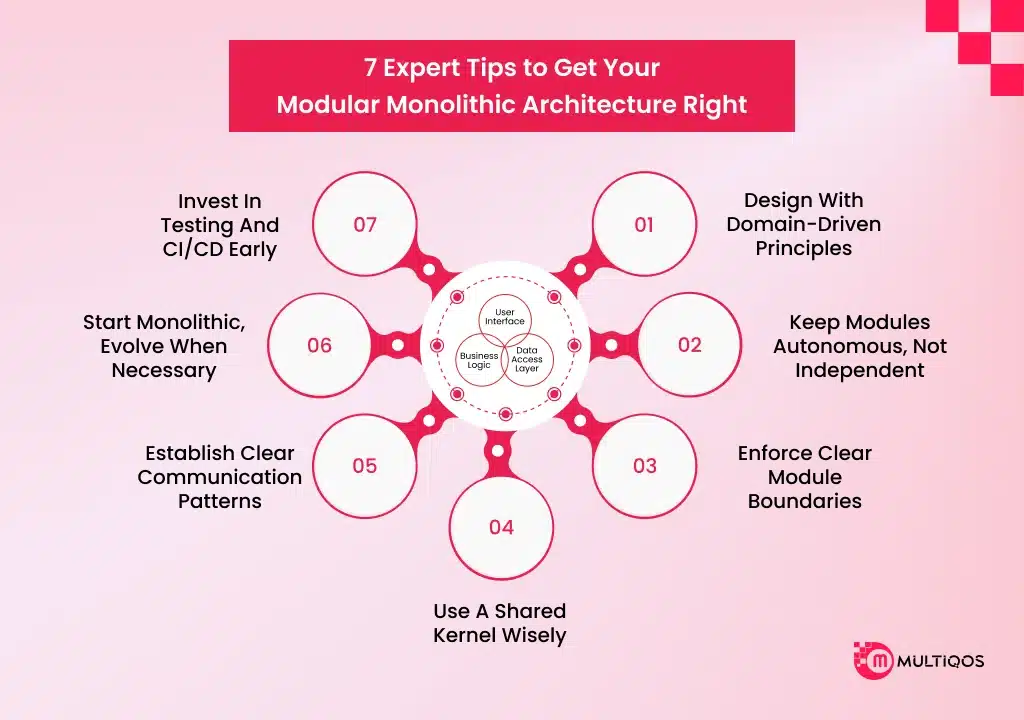Best Practices for Designing a Modular Monolithic Architecture

Summary:
A modular monolithic architecture combines the simplicity of a traditional monolith with the organized structure of modular design, making it an ideal choice for scalable and maintainable application development. This blog explores the best practices for designing such an architecture, including how to structure your codebase into cohesive modules, manage dependencies, enforce clear boundaries, and maintain flexibility without the complexity of microservices.
Whether you’re building a new system or refactoring an existing one, these insights will help you create a robust, efficient, and future-ready application.
Introduction
Talk to enough developers, and you’ll notice a pattern—monoliths often get brushed off as old-school or too clunky compared to microservices. These days, everyone seems eager to break things into dozens of little services. But the truth is that the level of complexity just isn’t necessary for every project. In fact, in many cases, it can do more harm than good.
That’s why modular monolithic architecture is worth a closer look. It sticks to a single, unified codebase but lets you divide things up internally in a clean, organized way. You still get structure, but without the headaches of managing a network of services. For teams juggling growing apps or trying to bring some order to legacy systems, this approach can be a real game-changer. In this post, we’ll walk through some practical ways to make it work—and a few common pitfalls to avoid along the way.
7 Expert Tips to Get Your Modular Monolithic Architecture Right
You might not want to manage a dozen moving parts on day one. That’s where microservices get a lot of attention nowadays, but they’re not always the right answer. If you’re building something complex, modular monolithic architecture come in. They’re cleaner than a monolithic, but without all the operational chaos of microservices.
That said, pulling it off well takes some serious planning. Whether you’re a startup or an established software development company, the challenges are real. Here are seven tips based on lessons learned the hard way—stuff you only really get after building (and fixing) this kind of system a few times.
1. Design with Domain-Driven Principles
Before diving into modular monolithic architecture implementation, take a step back and look at what the system actually does. Think in terms of business areas—like invoicing, user management, and order tracking. Each of these can become a separate module later.
This isn’t just a technical exercise. It helps everyone—from product to engineering—stay on the same page. If you’re guessing at the structure while you code, you’re setting yourself up for rewrites.
2. Keep Modules Autonomous, Not Independent
Here’s the deal: just because everything runs in the same process doesn’t mean it should act like one big blob. Your modular monolithic architecture and modules should handle their own responsibilities and expose just enough for the rest of the system to use them.
Ideally, one module doesn’t need to know how another works under the hood. They can talk—but through well-defined doors, not secret tunnels.
3. Enforce Clear Module Boundaries
You might think you’ll “just remember” which parts belong where. That lasts about a week. Instead, physically separate your code—put each module in its own folder, package, or project.
Then enforce it. Use whatever your language gives you to restrict access across modules. It might seem strict at first, but future you will thank present you when debugging is actually sane.
4. Use a Shared Kernel Wisely
It’s easy to toss helper functions or utility classes into a “common” folder. But that’s a slippery slope. Before long, everything lives there, and your clean modular plan falls apart.
Try this instead: if multiple modules need something, ask yourself if they should be sharing it. If it’s something like config or logging, sure. But if it’s business logic? Keep it where it belongs.
5. Establish Clear Communication Patterns
Let your modules talk—but don’t let them gossip. That means no one reaching into another module’s database or fiddling with its objects.
Use events, service interfaces, or even good old method calls—but make them official. When everything goes through a clear channel, it’s easier to test, debug, and evolve over time.
6. Start Monolithic, Evolve When Necessary
You might be tempted to break everything into microservices from the start. Don’t. That road comes with extra baggage: network calls, retries, observability overhead, the works.
A modular monolithic architecture keeps everything in one place, but still flexible. You can split out a service later if needed—but not every app grows that big, and that’s okay.
7. Invest in Testing and CI/CD Early
Here’s where most teams slip up. When it comes to modular monolithic architecture, they structure the code beautifully but leave testing as an afterthought. Then one change in one module quietly breaks five others.
Write unit tests for each module and add integration tests that cover how modules work together. And get those tests into your CI pipeline. It doesn’t have to be fancy—it just has to run.
Wrapping Up
Not every app needs to be sliced into microservices. That stuff can get messy fast. For a lot of teams, sticking with a modular monolithic architecture just makes more sense. You’ve got one codebase, but it’s broken into clear sections, so it doesn’t feel like one big tangled mess.
Chasing the latest trend is tempting, yeah. But sometimes it just overcomplicates things. What tends to work better? A setup where your code’s easy to find, easy to change, and doesn’t break five other things when you tweak one part. Been there, done that.
If you’re trying to start something clean or make sense of a legacy pile, this approach really helps. And if it’s too much to juggle on your own—or you just want to avoid wasting weeks—you could always bring someone in. You can also hire software developers who’ve worked on such projects, as it can be a lifesaver.
FAQs
Picture this: one app, one codebase. But instead of dumping everything into one big folder, you break it down inside, with different parts for different features. Maybe one for user stuff, another for payments, and so on. It’s still one thing you deploy, but inside, it’s way more organized and less of a pain to work with.
Honestly, it just makes life easier in a lot of cases. You only need to deploy one thing. Stuff runs faster since it’s all in-process. Fewer bugs from services not talking to each other properly. And for smaller teams, it’s quicker to build and change stuff. Microservices can be overkill when you’re just trying to get stuff done without spinning up 12 Docker containers.
If you’ve got a small team or if you’re still figuring out what the product is really supposed to do, modular monolithic architecture is usually the safer bet. You don’t have to build a whole network just to test a feature. And if you’re working on something that doesn’t need to scale for millions of users right away, it’s just less stress overall.
Yeah, a few things that help:
- Try to keep each module focused on one area, like billing or user auth.
- Don’t let them reach into each other’s logic — keep them kinda sealed off.
- If two modules need to talk, make it clear how to use interfaces or contracts.
- And use dependency injection—it keeps things flexible if you ever need to swap stuff out later.
Just don’t go overboard trying to make it perfect. Keep it clean, but practical.
Get In Touch







